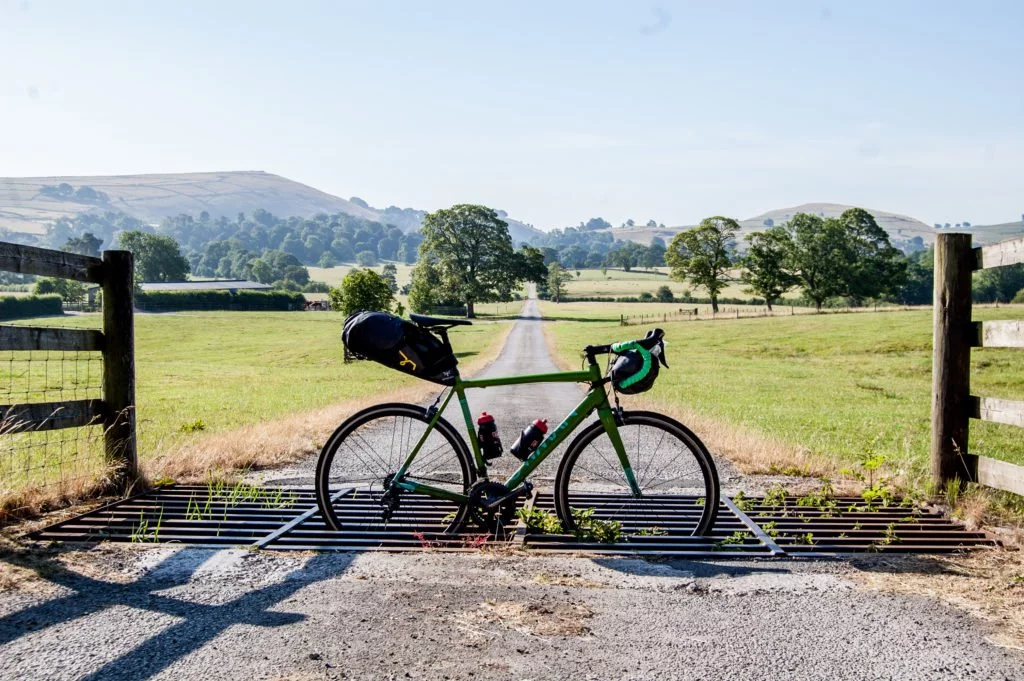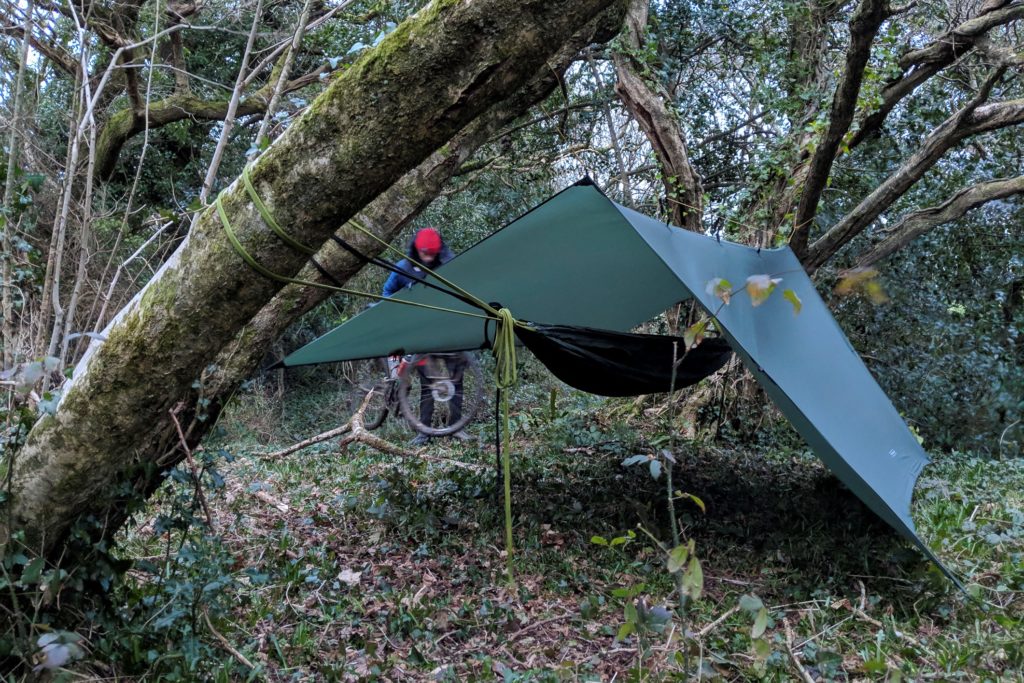Lockdown rules are relaxing but cycling has thankfully been allowed once a day since we were all asked to stay at home. A summer holiday abroad may not be on the cards this year for many, so why not try something closer to home and give some UK bike packing a go? You don’t need to be into ultra-endurance – the great thing about bike packing is that you get to choose the rules – where to ride, what to take, and where to sleep.

One bike, a long day and the freedom of the road – there is no more fully realised manifestation of this perfect scenario than ‘bikepacking’. Loosely defined as a combination of mountain biking and minimalist camping, it takes the freedom of cross-country hiking and adds the long range of the off-road bicycle.
Founded on flexibility, bikepacking allows its participants the open-mindedness to head down the unmarked trail just because it’s there, regardless of its destination; it is the epitome of exploring the road less travelled, be it dirt, singletrack or gravel, all while carrying the bare essentials for a night under the stars.
In a world of power meters, interval training and virtual reality, bikepacking is the contradiction to the trend. It’s cycling’s counter-culture, popular because it turns away from the rigidity of facts and figures. It gets back down to the root of why we all got into cycling in the first place: the freedom to explore.
As with oh-so-many cycling disciplines, it is assumed that getting into bikepacking will cost newbies an arm and a leg, but this is a common misconception. Granted, if you stick at it, you’ll gradually accumulate various tangible and intangible additions, from lightweight gear to valuable advice, but take a breath, slow down – bikepacking is simpler than you think.
It’s fair to say that the British bikepacking scene is blossoming with health and there is no shortage of experts with heads full of experience to harvest. There is no bikepacking playbook that dictates the discipline; you’ll quickly find that each individual has their own way of doing things and it is that freedom that defines it.
View this post on Instagram
Equipment
Ultimately, the ideal bike for bikepacking simply has two strong wheels and goes forward – there is no such thing as a ‘bikepacking bike’. Katherine Moore, GCN correspondent and self-described “friendly Westcountry type”, is an enthusiastic adventurer and bike rider whose experience is based on experimentation. Of the bike, Katherine says:
“It’s a bike, that’s all. While it can be your everyday commuter or a specialist setup, what really matters is that you just get out there and go for it. To me, bikepacking is off-road touring, so unless it’s bone-dry smooth trails that you stumble upon (good luck with that in the UK), you’re likely to need some knobbly tyres. The larger the volume, the more comfortable you’ll be, and more aggressive tread patterns will help you churn through stickier mud with (relative) ease.”
For ultra-endurance cyclist, Alex Hill, comfort is key: “If you are heading out on a multi-day ride you need to be comfortable, so a bike with a more relaxed geometry tends to work better than an all-out race bike. With mine, I’ve concentrated on making my long rides as comfortable as possible by adding fixed metal mudguards to keep the inevitable rain off, 32mm road tyres at a fairly low pressure (the UK roads can be unforgiving most of the time!) and finally I’ve increased the range of gears on the bike to make climbing a little easier when loaded with bags.”
View this post on Instagram
One of the more obvious differences, at least aesthetically, between bikepacking and good old-fashioned touring is the means by which the bike is loaded, i.e. frame bags rather than panniers. Travelling light is characteristic of bikepacking, making frame bags the natural choice as they are lighter, easier to fit and more versatile. Alex tells us that “the beauty of the modern bikepacking movement and the fantastic technology in bags/equipment mean that you can fix a bag to pretty much any bike, pack some essentials and head off on an adventure.”
There are plenty of options when it comes to frame bags too, with the seatpost, top tube and handlebars all providing ample room to attach the necessary equipment. Katherine says, “you want to carry as much weight over your bottom bracket as possible. I find the majority of my kit in a seatpost bag works best, with additional lighter kit in a handlebar bag.”
Though we’ve established that to get into bikepacking, there is no obligation to spend enormous amounts of money on a new bike, wheels or equipment, there are adjustments that you might find useful as you get deeper into it. Yes, minimal baggage and a lightweight setup are key considerations, but you’ll still find that the extra weight may slow you down. For this reason, many bikepacking setups will have larger gear ranges than conventional cyclocross or road bikes. Opting for a 42-tooth cassette will make life considerably easier and more comfortable over the rough and ready off-road trails frequented by bikepackers.
What to pack
So, you’ve got your bike and a selection of frame bags. Now, what to take with you? There is a fantastically comprehensive list of essential gear on the Bikepacking website which includes sleeping gear, compact stove and food, tools for emergency maintenance, water and additional layers – basically, the bare minimum that you’ll need to survive a night out under the stars book-ended by riding your bike.
Katherine is an advocate for experimentation and has taken to carrying a hammock rather than the wherewithal for bivvying: “There’s no point in doing things differently for the sake of it but where experimentation yields interesting results, it can be really useful! I’m in love with hammocking now as I like to get ‘foetal’ when I sleep, and personally find it much cosier than bivvying. It’s been really fun learning to sling a hammock in places where there are no trees; lots of outside the box thinking!”

Both of our experts never leave the house without a small toolkit for unexpected situations, complete with a good multi-tool (chain breaker and split link included), cable ties, electrical tape and super glue. They also emphasise the importance of additional layers and accessories, like a Buff neck scarf, base layer, jacket, and long-johns to wear overnight.
“A packable insulated jacket is key,” says Katherine. “Pack it near the top of your bag for easy access and put it on straight away when you stop to set up camp, have a mechanical or are simply stopping for a tea break – conserving heat is so important.”
One seldom discussed item that you might consider is a bum bag, something which Katherine is rarely without, again playing into her experimental nature which is shared by many in the bikepacking community. “A bum bag offers loads of space for sandwiches and other snacks,” she assures us, “as well as easy to access items like charging cables and tools. Surprisingly, I don’t feel it there when it’s on me, plus it means that I can go pocket-free with my clothing and choose more casual kit than conventional lycra.”
Last but most certainly not least, Alex’s golden ticket item is a good set of lights that you can wholeheartedly trust: “Inevitably, you’re going to have a ride that runs over into darkness, or perhaps you plan on riding through the night. Good, dependable lights are an absolute necessity. I fully trust Exposure lights as they provide excellent run time and light weight.”
View this post on Instagram
Preparation
Now that bike and kit are sorted, it’s time to plan the ride itself. Once again, there is no pre-ordained network for bikepacking rides; in fact, grab the nearest map and you can – and should – take literally any track, no matter how thin the line. Many keen bikepackers are self-confessed ‘map geeks’, born with a feverish desire for exploration, to go to the end of every path, track or trail that they find themselves on.
In the modern world, we have access to a range of apps and platforms for route-planning, as well as a choice of devices to follow them on. Alex Hill uses a combination of Strava and Google Street View to plan his routes, assessing the practicality and passability of the trails before the tyres meet the dirt. Strava is not the most popular planning tool but Alex says that the ‘heatmaps’ function is one big thing it has in its favour; “it lets you see what routes are popular in a given area, and so may be of interest.”
While Katherine also loves maps and route-planning – herself a champion of Komoot – she says, “what shouldn’t be underestimated is the value in real life route sharing and exploration. Roll up to organised gravel rides and you’ll get incredible routes put together by local experts or check out forums like Bikepacking.com for inspiration.”
View this post on Instagram
Finally, as Katherine will confirm, there’s no better feeling than simply letting inspiration strike and exploring any intriguing path or bridleway that winds off into the distance. The worst-case scenario is that you’ll have to turn back, but you never know, you might stumble upon the most amazing, all but untouched, new singletrack.
Setting out
If there were a bikepacking starter kit, the one thing it would definitely include is a fun, flexible and open-minded attitude to route-planning. Also important are a comfortable bike, plenty of warm layers and possibly a bum bag… Above all, what matters is to get out into the fresh air, have fun and enjoy the freedom of the ride.
Both our experts, Katherine Moore and Alex Hill, are preparing for some pretty epic bikepacking adventures this year, so be sure to follow them on Instagram at @katherinebikes and @ajh_cycling.
If you’re ready to get out on the trails for your first adventure, you’ll be pleased to hear you’re covered for off-road riding in the UK and Europe by our Performance Bicycle Insurance, our policy for the enthusiastic cyclist.